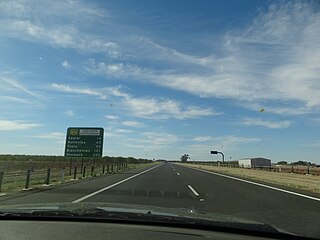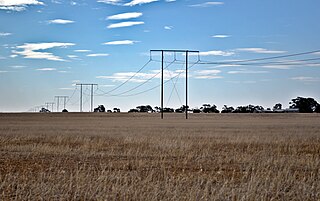
Gawler is the oldest country town on the Australian mainland in the state of South Australia. It was named after the second Governor of the colony of South Australia, George Gawler. It is about 40–44 km (25–27 mi) north of the centre of the state capital, Adelaide, and is close to the major wine producing district of the Barossa Valley. Topographically, Gawler lies at the confluence of two tributaries of the Gawler River, the North and South Para rivers, where they emerge from a range of low hills.

The Sturt Highway is an Australian national highway in New South Wales, Victoria, and South Australia. The Sturt Highway is an important road link for the transport of passengers and freight between Sydney and Adelaide and the regions situated adjacent to the route.

The rail network in Adelaide, South Australia, consists of six lines and 89 stations, totalling 125.9 km. It is operated by Adelaide Metro, and is part of the citywide Adelaide Metro public transport system.
Port Wakefield Road and Port Wakefield Highway are an important South Australian highway. They connect Adelaide to the Yorke Peninsula, Port Augusta, northern and western South Australia, the Northern Territory and Western Australia. They are designated National Highway A1 and a part of the National Highway. They are named after Port Wakefield, the first government town north of Adelaide. Historically, the whole route was named Port Wakefield Road, however following the opening of the Northern Expressway, the route north of that junction was named Port Wakefield Highway.

Main North Road is the major north-south arterial route through the suburbs north of the Adelaide City Centre in the city of Adelaide, South Australia. It continues north through the settled areas of South Australia and is a total of 307 kilometres (191 mi) long, from North Adelaide to 21 kilometres (13 mi) out of Port Augusta. It follows the route established in the early years of the colony by explorer John Horrocks and was a major route for farmers and graziers to reach the capital, passing through rich farmland and the Clare Valley wine region. In 2011, the section of road between Gawler to Wilmington was renamed Horrocks Highway.

The Outer Harbor railway line is a suburban branch line in Adelaide, South Australia. It runs from Adelaide station through the north western suburbs to Port Adelaide and Outer Harbor. It is 21.9 kilometres in length, and shares part of its run with the Grange line. It is operated by Adelaide Metro.

The Gawler railway line is a suburban commuter railway line in the city of Adelaide, South Australia. It is the only rail route in Adelaide to have no interchange with another line at any station except Adelaide.

The Grange railway line is a suburban branch line in Adelaide, South Australia.

Laing O'Rourke is a multinational construction company headquartered in Dartford, England, United Kingdom. It was founded in 1978 by Ray O'Rourke. It is the largest privately owned construction company in the United Kingdom.
The Port River Expressway is a 5.5-kilometre (3.4 mi) freeway-grade road. The expressway links Port Adelaide and the LeFevre Peninsula to the northern suburbs of Adelaide and major interstate routes via Salisbury Highway (A9) to Port Wakefield Road (A1) and the Max Fatchen Northern Expressway (M2) to Perth, Darwin and Sydney.

The Northern Expressway, also known as the Fatchen Northern Expressway, is a 23 kilometre long controlled-access highway in Adelaide, South Australia. It travels from Gawler to Port Wakefield Road. The road has been built to four-lane standard and provides a faster route between Adelaide and Gawler, whilst reducing the amount of traffic on Main North Road, which passes through the heart of the northern suburbs and is interspersed with frequent traffic lights. It also allows freight vehicles to avoid residential areas and go straight to Port Wakefield Road. Since March 2020, the North–South Motorway continues west of Port Wakefield Road and intersects the Port River Expressway (A9) to reach the harbour at Port Adelaide. These are the northernmost two parts of the North–South Corridor.

The John Holland Group is a construction, tunnelling, rail, building and services provider with operations in Australia, New Zealand, South East Asia and the Middle East. Headquartered in Melbourne, it is a subsidiary of China Communications Construction.
Gawler Bypass is a major north–south route in the outer northern suburbs of the city of Adelaide, South Australia. It had the national designation of National Highway A20 north of the Northern Expressway, while south of this intersection it had the state designation of A52. From late 2016, the entire length was designated A20, corresponding to the Northern Expressway being designated M2.

The North–South Motorway is an incomplete planned motorway traversing the inner western suburbs of Adelaide from Waterloo Corner in the north to Bedford Park in the south. Progressively constructed in stages since 2010, once complete it will replace the adjacent South Road as Adelaide's main north-south roadway and form the central section of the North–South Corridor, being flanked north and south by the Northern Expressway and Southern Expressway, respectively.

The North–South Corridor is a series of road projects currently under construction or planning which travel through Adelaide, South Australia that will eventually form a continuous link from Old Noarlunga in the outer southern metropolitan Adelaide suburbs through to Nuriootpa in the inner northern rural area around the Barossa Valley, a distance of over 100 km, aiming to be without a single stop by 2030.

The Bunyip is a weekly newspaper, first printed on 5 September 1863, and originally published and printed in Gawler, South Australia. Its distribution area includes the Gawler, Barossa, Light, Playford, and Adelaide Plains areas. Along with The Murray Pioneer, The River News, and The Loxton News,The Bunyip was now owned by the Taylor Group of Newspapers and printed in Renmark.

Cape Hardy is a 20 m (66 ft) high, dune-capped granite headland on the eastern coast of Eyre Peninsula and which protrudes into Spencer Gulf in South Australia. It is located between the towns of Port Neill and Tumby Bay, 10 km (6.2 mi) north-northeast of Lipson Cove.

Perry Engineering was a major foundry and steel engineering works in the state of South Australia.

Buchfelde is now a suburb of Gawler, South Australia, on the northern outskirts of Adelaide in South Australia.

Reeves Plains Power Station is a proposal from Alinta Energy to build a gas-fired power station at Reeves Plains between Gawler and Mallala in South Australia. The proposed site borders both the Moomba-Adelaide gas pipe and an electricity transmission line. The power station is proposed to use six gas turbines to produce up to 300 megawatts (400,000 hp) of electricity. It is expected to be operated as a peaking plant rather than running full time. The primary source of fuel will be the gas pipeline, however the plant will also be able to operate on diesel fuel, and will have diesel storage on site. Stage 1 is expected to only be two or three of the turbines, generating 100 to 150 MW of electricity. The power station was originally expected to take 12 months to build, and be commissioned in January 2019. An extension of time request granted an additional 12 months in February 2019, but as of November 2019, the Alinta board had not yet decided to make the investment.
















